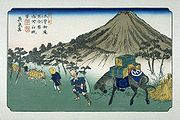
Oiwake-shuku
Encyclopedia

69 Stations of the Nakasendo
The are the rest areas along the Nakasendō, which ran from Nihonbashi in Edo to Sanjō Ōhashi in Kyoto. The route stretched approximately and was an alternate trade route to the Tōkaidō.-Stations of the Nakasendō:...
of the Nakasendō
Nakasendo
The , also called the , was one of the five routes of the Edo period, and one of the two that connected Edo to Kyoto in Japan. There were 69 stations between Edo and Kyoto, crossing through Musashi, Kōzuke, Shinano, Mino and Ōmi provinces...
. It is located in the present-day town of Karuizawa
Karuizawa, Nagano
is a town located in Kitasaku District, Nagano, Japan.As of January 1, 2008, the town has an estimated population of 17,833 and has a total area of ....
, in the Kitasaku District
Kitasaku District, Nagano
is a district located in Nagano Prefecture, Japan.As of December 1, 2005, the district has an estimated population of 40,041.The district has three towns*Karuizawa*Miyota*Tateshina-District Timeline:...
of Nagano Prefecture
Nagano Prefecture
is a prefecture of Japan located in the Chūbu region of the island of Honshū. The capital is the city of Nagano.- History :Nagano was formerly known as the province of Shinano...
, Japan
Japan
Japan is an island nation in East Asia. Located in the Pacific Ocean, it lies to the east of the Sea of Japan, China, North Korea, South Korea and Russia, stretching from the Sea of Okhotsk in the north to the East China Sea and Taiwan in the south...
.
History
This post town was named Oiwake, which means "where two roads split," because it was at this point that the Nakasendō split from the Hokkoku KaidōHokkoku Kaido
The was a highway in Japan during the Edo period. It was a secondary route, ranked below the Edo Five Routes in importance. Because it was developed for travelers going to Zenkō-ji, it was also called Zenkō-ji Kaidō . It stretched from the Nakasendō's Oiwake-juku to the Hokurikudō's Takada-shuku...
. In the late 17th century, during the Genroku period
Genroku
was a after Jōkyō and before Hōei. This period spanned the years from September 1688 through March 1704. The reigning emperor was .The years of Genroku are generally considered to be the Golden Age of the Edo Period. The previous hundred years of peace and seclusion in Japan had created relative...
, it flourished as a post town that could hold over 200 guests. There are still many remnants from the Edo period
Edo period
The , or , is a division of Japanese history which was ruled by the shoguns of the Tokugawa family, running from 1603 to 1868. The political entity of this period was the Tokugawa shogunate....
in the town today.
Though not a neighboring post town, Matsuida-shuku
Matsuida-shuku
was the sixteenth of the sixty-nine stations of the Nakasendō. It is located in the present-day city of Annaka, Gunma Prefecture, Japan, at the foot of Mount Myōgi.-Travel towards Kyoto:...
also provides a direct connection to Oiwake-shuku along the Nakasendō, by way of a minor hime kaidō
Hime kaido
was the name given to minor routes that created detours around the difficult crossings of main routes during the Edo period in Japan...
. This hime kaidō allows travelers to avoid the Usuinoseki Checkpoint, one of the major checkpoints along the highway.
Neighboring post towns
Nakasendō- Kutsukake-shukuKutsukake-shukuwas the nineteenth of the sixty-nine stations of the Nakasendō. It is located in the present-day town of Karuizawa, in the Kitasaku District of Nagano Prefecture, Japan.-History:...
- Oiwake-shuku - Otai-shukuOtai-shukuwas the twenty-first of the sixty-nine stations of the Nakasendō. It is located in the present-day town of Miyota, in the Kitasaku District of Nagano Prefecture, Japan.-History:...
Hokkoku Kaidō
- Oiwake-shuku (starting location) - Komoro-shuku

